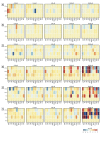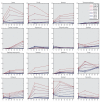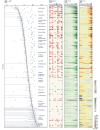Using ToxCast™ Data to Reconstruct Dynamic Cell State Trajectories and Estimate Toxicological Points of Departure
- PMID: 26473631
- PMCID: PMC4937847
- DOI: 10.1289/ehp.1409029
Using ToxCast™ Data to Reconstruct Dynamic Cell State Trajectories and Estimate Toxicological Points of Departure
Abstract
Background: High-content imaging (HCI) allows simultaneous measurement of multiple cellular phenotypic changes and is an important tool for evaluating the biological activity of chemicals.
Objectives: Our goal was to analyze dynamic cellular changes using HCI to identify the "tipping point" at which the cells did not show recovery towards a normal phenotypic state.
Methods: HCI was used to evaluate the effects of 967 chemicals (in concentrations ranging from 0.4 to 200 μM) on HepG2 cells over a 72-hr exposure period. The HCI end points included p53, c-Jun, histone H2A.x, α-tubulin, histone H3, alpha tubulin, mitochondrial membrane potential, mitochondrial mass, cell cycle arrest, nuclear size, and cell number. A computational model was developed to interpret HCI responses as cell-state trajectories.
Results: Analysis of cell-state trajectories showed that 336 chemicals produced tipping points and that HepG2 cells were resilient to the effects of 334 chemicals up to the highest concentration (200 μM) and duration (72 hr) tested. Tipping points were identified as concentration-dependent transitions in system recovery, and the corresponding critical concentrations were generally between 5 and 15 times (25th and 75th percentiles, respectively) lower than the concentration that produced any significant effect on HepG2 cells. The remaining 297 chemicals require more data before they can be placed in either of these categories.
Conclusions: These findings show the utility of HCI data for reconstructing cell state trajectories and provide insight into the adaptation and resilience of in vitro cellular systems based on tipping points. Cellular tipping points could be used to define a point of departure for risk-based prioritization of environmental chemicals.
Citation: Shah I, Setzer RW, Jack J, Houck KA, Judson RS, Knudsen TB, Liu J, Martin MT, Reif DM, Richard AM, Thomas RS, Crofton KM, Dix DJ, Kavlock RJ. 2016. Using ToxCast™ data to reconstruct dynamic cell state trajectories and estimate toxicological points of departure. Environ Health Perspect 124:910-919; http://dx.doi.org/10.1289/ehp.1409029.
Conflict of interest statement
The views expressed in this article are those of the authors and do not necessarily represent the views or policies of the U.S. EPA. The authors declare they have no actual or potential competing financial interests.
Figures





Similar articles
-
On the Utility of ToxCast™ and ToxPi as Methods for Identifying New Obesogens.Environ Health Perspect. 2016 Aug;124(8):1214-26. doi: 10.1289/ehp.1510352. Epub 2016 Jan 13. Environ Health Perspect. 2016. PMID: 26757984 Free PMC article.
-
Prioritizing Environmental Chemicals for Obesity and Diabetes Outcomes Research: A Screening Approach Using ToxCast™ High-Throughput Data.Environ Health Perspect. 2016 Aug;124(8):1141-54. doi: 10.1289/ehp.1510456. Epub 2016 Mar 15. Environ Health Perspect. 2016. PMID: 26978842 Free PMC article.
-
Systems Toxicology of Male Reproductive Development: Profiling 774 Chemicals for Molecular Targets and Adverse Outcomes.Environ Health Perspect. 2016 Jul;124(7):1050-61. doi: 10.1289/ehp.1510385. Epub 2015 Dec 11. Environ Health Perspect. 2016. PMID: 26662846 Free PMC article.
-
The Next Generation of Risk Assessment Multi-Year Study-Highlights of Findings, Applications to Risk Assessment, and Future Directions.Environ Health Perspect. 2016 Nov;124(11):1671-1682. doi: 10.1289/EHP233. Epub 2016 Apr 19. Environ Health Perspect. 2016. PMID: 27091369 Free PMC article. Review.
-
Safety and nutritional assessment of GM plants and derived food and feed: the role of animal feeding trials.Food Chem Toxicol. 2008 Mar;46 Suppl 1:S2-70. doi: 10.1016/j.fct.2008.02.008. Epub 2008 Feb 13. Food Chem Toxicol. 2008. PMID: 18328408 Review.
Cited by
-
Altered network and rescue of human neurons derived from individuals with early-onset genetic epilepsy.Mol Psychiatry. 2021 Nov;26(11):7047-7068. doi: 10.1038/s41380-021-01104-2. Epub 2021 Apr 22. Mol Psychiatry. 2021. PMID: 33888873 Free PMC article.
-
Using high throughput screens to predict miscarriages with placental stem cells and long-term stress effects with embryonic stem cells.Birth Defects Res. 2022 Oct 1;114(16):1014-1036. doi: 10.1002/bdr2.2079. Epub 2022 Aug 18. Birth Defects Res. 2022. PMID: 35979652 Free PMC article. Review.
-
Sources, mechanisms, and consequences of chemical-induced mitochondrial toxicity.Toxicology. 2017 Nov 1;391:2-4. doi: 10.1016/j.tox.2017.06.002. Epub 2017 Jun 13. Toxicology. 2017. PMID: 28627407 Free PMC article.
-
Progress in data interoperability to support computational toxicology and chemical safety evaluation.Toxicol Appl Pharmacol. 2019 Oct 1;380:114707. doi: 10.1016/j.taap.2019.114707. Epub 2019 Aug 9. Toxicol Appl Pharmacol. 2019. PMID: 31404555 Free PMC article. Review.
-
Incorporating new approach methodologies in toxicity testing and exposure assessment for tiered risk assessment using the RISK21 approach: Case studies on food contact chemicals.Food Chem Toxicol. 2019 Dec;134:110819. doi: 10.1016/j.fct.2019.110819. Epub 2019 Sep 20. Food Chem Toxicol. 2019. PMID: 31545997 Free PMC article.
References
-
- Blackman RB, Tukey JW. New York: Dover Publications Inc; 1958. The Measurement of Power Spectra from the Point of View of Communications Engineering.
-
- Boekelheide K, Andersen ME. A mechanistic redefinition of adverse effects – a key step in the toxicity testing paradigm shift. ALTEX. 2010;27:243–252. - PubMed
-
- Cellomics. Pittsburgh, PA: Cellomics Inc; 2007a. Cell Cycle BioApplication Guide.
Publication types
MeSH terms
Substances
LinkOut - more resources
Full Text Sources
Other Literature Sources
Research Materials
Miscellaneous

